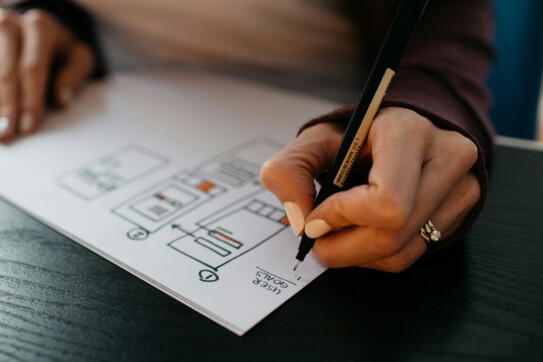3 Quick Tips for a Better Nonprofit Website Aesthetic

When you think of the most critical tools for driving your nonprofit’s mission forward, what comes to mind? You might consider your CRM, donation processor, or the platforms you use to manage community programs and services. But if your organization’s website isn’t on your list, it should be!
A well-designed website can work wonders for your nonprofit in spreading awareness of your mission and converting first-time visitors into loyal, active supporters. While many factors can make or break a website, one of the most notable is its aesthetic. If your site looks professional and inviting, users will have a better browsing experience and be more likely to return.
In this guide, we’ll walk through three tips to take your nonprofit’s website aesthetic to the next level. Whether you’re just building your organization’s first website or are considering redesigning your existing one, you’ve come to the right place for a crash course in visual web design. Let’s dive in!
1. Emphasize your brand identity
For-profit companies use branding to establish their credibility and sell their products to customers. If you bought a bottle of Coca-Cola, for example, its red-and-white label and Spencerian script logo would let you know what kind of flavor and quality you could expect from the beverage inside.
Even though your nonprofit isn’t selling a tangible product, you stillneed to “sell” potential supporters on your mission to get them to engage with you. To accomplish this, incorporate key nonprofit branding elements across your entire website, including your organization’s:
- Logo. As the visual representation of your nonprofit’s mission and values, your logo should be visible on every page of your website. The best way to do this is to place it in the top corner of your sticky navigation bar and include a link back to your homepage.
- Color palette. Your nonprofit likely has one or two main colors to incorporate into all of your design work, as well as some secondary shades to add visual variety. To make your site accessible for all audiences, always ensure there is adequate contrast between text and background colors (at least a 4.5:1 ratio for copy and 3:1 for headings).
- Typography. Sans serif fonts are easiest to read on screens, but within that category, you have tons of options for font families, sizes, and weights. However, to avoid a cluttered look, don’t use more than three typefaces on any page.
To keep your branding consistent across your entire website, create a digital style guide that lays out all acceptable variations of your logo, the names and unique hex codes of each of your brand colors (e.g., “maroon” could be #73000a or #695351), and font usage guidelines. This will serve as the source of truth for anyone inside or outside your nonprofit who works on your website.
2. Prioritize clean, streamlined design
When you get started with web design, it’s easy to get caught up in all of the bells and whistles you can add to various pages. However, the more streamlined your site is, the easier it will be for visitors to find the information they’re looking for and take action to support your nonprofit.
Here are some ways to simplify your website design to improve user experience:
- Develop intuitive, responsive navigation. Organize your site menu and footer logically with just a few key headings and subheadings. Then, add call-to-action buttons to highlight your most important pages, like your contact page and donation page. Once you’ve built your navigation bar, test it on both desktop and mobile to ensure it’s optimized for all devices.
- Make forms easy to fill out. The longer your online donation form and registration forms are, the more likely supporters will be to abandon them. Limit form fields to essential information, and use a secure donation processor that allows donors to save their payment details for future contributions.
- Embrace white space. The spaces you don’t fill with content are almost as important as what you put on your website. Leaving some white space between and around the text and images on your site makes it easier for supporters to digest and focus on the content.
Pro tip: Using an intuitive website builder with customizable templates will allow you to build a clean, professional-looking website—even if you have no website development or coding experience!
3. Incorporate high-quality multimedia elements
They say a picture is worth a thousand words, which rings very true with nonprofit website design. As Cornershop Creative explains, “Even before a visitor reads a single word, they already understand volumes about your organization with the images…displayed on your website.”
Add the following types of multimedia content to your site to make it more visually interesting for users:
- Photos. Whether you display images of your volunteers hard at work or your beneficiaries joyfully receiving your services, photos can put a face to your organization’s work so audiences connect more deeply with it. Always make sure to obtain consent from human subjects before using their photos on your website or in any promotional materials.
- Infographics. Your organization’s impact data will be much easier for website visitors to understand and contextualize if you present it using charts, tables, and graphs. Depending on your website builder, you may even be able to make these infographics interactive to engage users more effectively.
- Video embeds. High-quality videos engage users with both visuals and audio, giving a new perspective on your work. You could create a variety of videos for different purposes, from testimonials that show donors the impact of their gifts to recaps of previous years’ fundraising events that encourage more signups for this year’s event.
The two main challenges that come with multimedia website content are minimizing the impact on page load speed and ensuring accessibility. Compress and properly size image and video files to allow them to load quickly, creating a better user experience. Additionally, include alternative text for images and closed captions for videos so all users can gain value from your website’s media.
These tips are a solid starting point for your nonprofit to create an aesthetically pleasing website. As you implement them, monitor your site’s performance and collect user feedback to see which strategies work well and where you could improve. Additionally, don’t hesitate to reach out to nonprofit web design professionals if you need help or have questions at any stage of the process.
